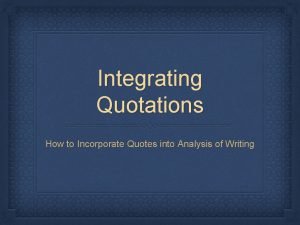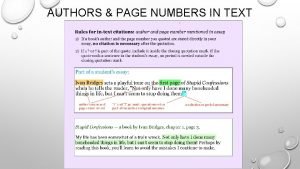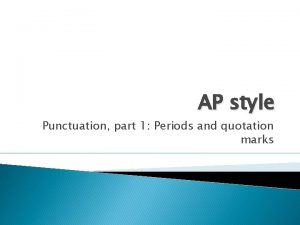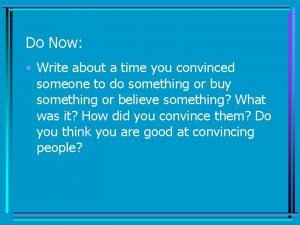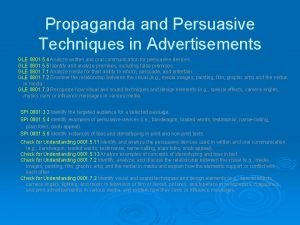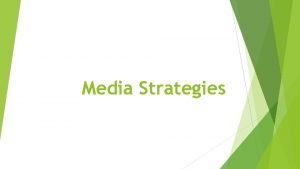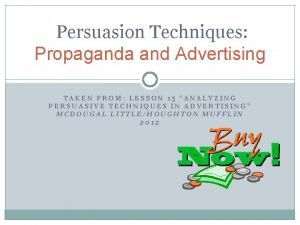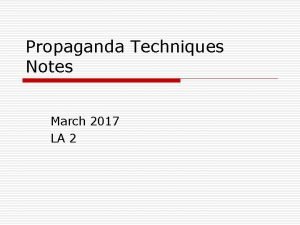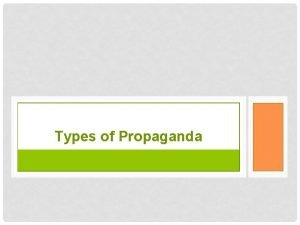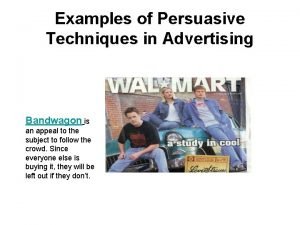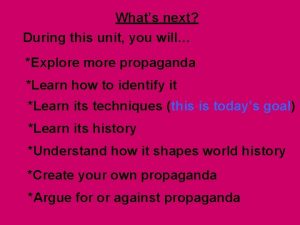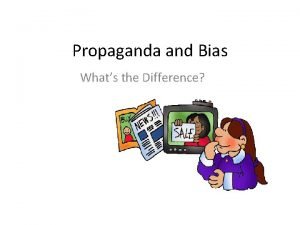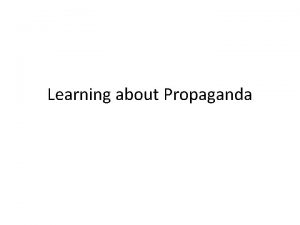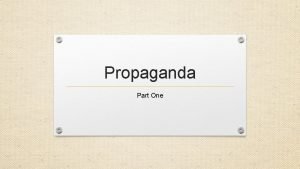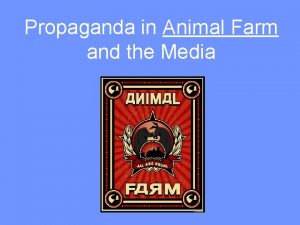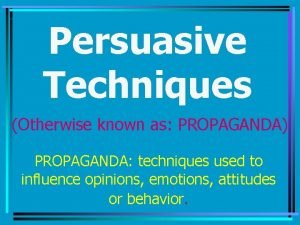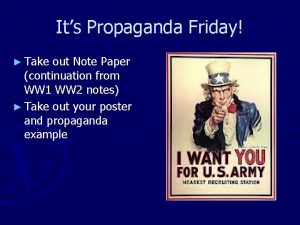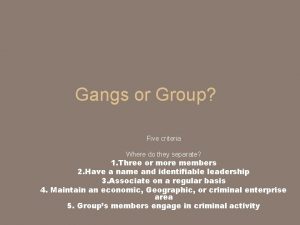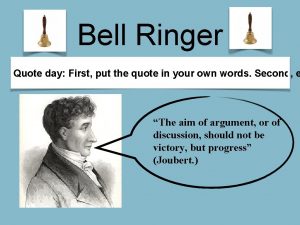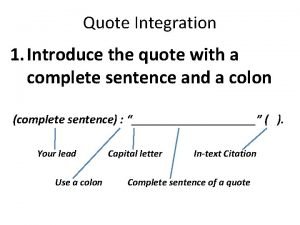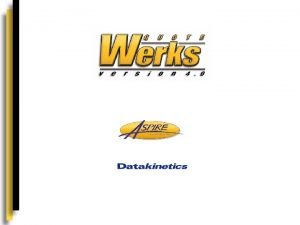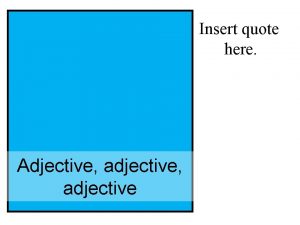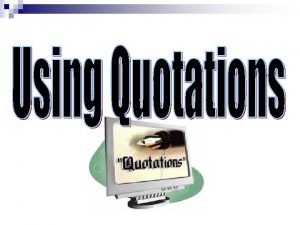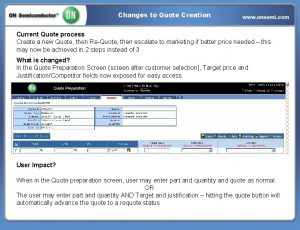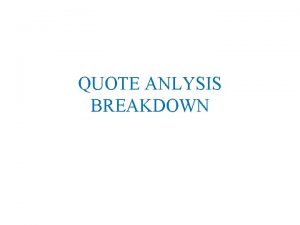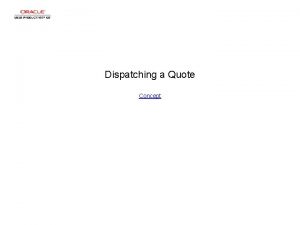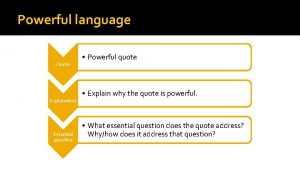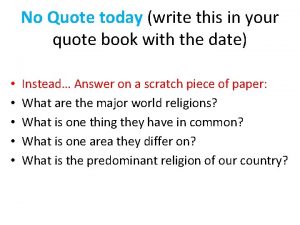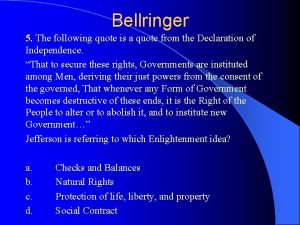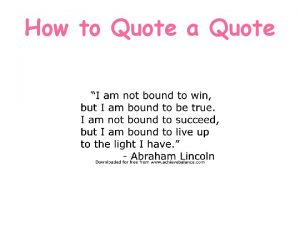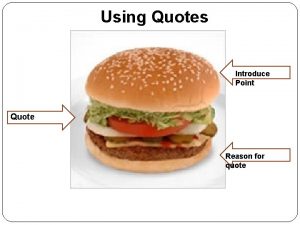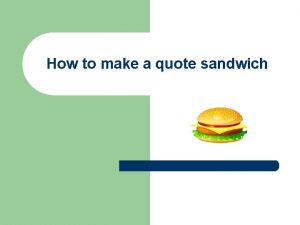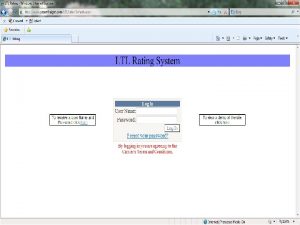Quote of the day 95 of the folks

































- Slides: 33

Quote of the day “ 95% of the folks out there are completely clueless about floating-point. ” James Gosling Sun Fellow Java Inventor 1998 -02 -28 CS 314 Chapter 3. 1 CSE, 2016

Goals for Floating Point q Standard arithmetic for reals for all computers l Like two’s complement q Keep as much precision as possible in formats q Help programmer with errors in real arithmetic l q +∞, -∞, Not-A-Number (Na. N), exponent overflow, exponent underflow Keep encoding that is somewhat compatible with two’s complement E. g. , 0 in Fl. Pt. is 0 in two’s complement l Make it possible to sort without needing to do floating point comparison l CS 314 Chapter 3. 2 CSE, 2016

Scientific Notation (e. g. , Base 10) q Normalized scientific notation (aka standard form or exponential notation): r x Ei, E is exponent (usually 10), i is a positive or negative integer, r is a real number ≥ 1. 0, < 10 l Normalized => No leading 0 s l 61 is 6. 10 x 102, 0. 000061 is 6. 10 x 10 -5 l CS 314 Chapter 3. 3 CSE, 2016

Scientific Notation (e. g. , Base 10) q (r x ei) x (s x ej) = (r x s) x ei+j (1. 999 x 102) x (5. 5 x 103) = (1. 999 x 5. 5) x 105 = 10. 9945 x 105 = 1. 09945 x 106 q (r x ei) / (s x ej) = (r / s) x ei-j (1. 999 x 102) / (5. 5 x 103) = 0. 3634545… x 10 -1 = 3. 634545… x 10 -2 q For addition/subtraction, you first must align: (1. 999 x 102) + (5. 5 x 103) = (. 1999 x 103) + (5. 5 x 103) = 5. 6999 x 103 CS 314 Chapter 3. 4 CSE, 2016

Floating Point: Representing Very Small Numbers q Zero: Bit pattern of all 0 s is encoding for 0. 000 But 0 in exponent should mean most negative exponent (want 0 to be next to smallest real) Can’t use two’s complement (1000 0000 two) q Bias notation: subtract bias from exponent l q Single precision uses bias of 127; DP uses 1023 0 uses 0000 two => 0 -127 = ∞, Na. N uses 1111 two => 255 -127 = +128 -127; Smallest SP real can represent: 1. 00… 00 x 2 -126 l Largest SP real can represent: 1. 11… 11 x 2+127 l CS 314 Chapter 3. 5 CSE, 2016

Bias Notation (+127) How it is interpreted How it is encoded ∞, Na. N Getting closer to zero Zero CS 314 Chapter 3. 6 CSE, 2016

What About Real Numbers in Base 2? qr x Ei, E where exponent is (2), i is a positive or negative integer, r is a real number ≥ 1. 0, < 2 q Computers version of normalized scientific notation called Floating Point notation CS 314 Chapter 3. 7 CSE, 2016

Floating Point Numbers q 32 -bit word has 232 patterns, so must be approximation of real numbers ≥ 1. 0, < 2 q IEEE 754 Floating Point Standard: 1 bit for sign (s) of floating point number l 8 bits for exponent (E) l 23 bits for fraction (F) (get 1 extra bit of precision if leading 1 is implicit) l (-1)s x (1 + F) x 2 E q Can represent from 2. 0 x 10 -38 to 2. 0 x 1038 CS 314 Chapter 3. 8 CSE, 2016

Floating Point Numbers q What about bigger or smaller numbers? q IEEE 754 Floating Point Standard: Double Precision (64 bits) 1 bit for sign (s) of floating point number l 11 bits for exponent (E) l 52 bits for fraction (F) (get 1 extra bit of precision if leading 1 is implicit) l (-1)s x (1 + F) x 2 E q Can represent from 2. 0 x 10 -308 to 2. 0 x 10308 q 32 bit format called Single Precision CS 314 Chapter 3. 9 CSE, 2016

Representing Big (and Small) Numbers What if we want to encode the approx. age of the earth? q 4, 600, 000 or 4. 6 x 109 or the weight in kg of one a. m. u. (atomic mass unit) 0. 0000000000000166 or 1. 6 x 10 -27 There is no way we can encode either of the above in a 32 -bit integer. q Floating point representation l (-1)sign x F x 2 E Still have to fit everything in 32 bits (single precision) s E (exponent) 1 bit 8 bits F (fraction) 23 bits l The base (2, not 10) is hardwired in the design of the FPALU l More bits in the fraction (F) or the exponent (E) is a trade-off between precision (accuracy of the number) and range (size of the number) CS 314 Chapter 3. 10 CSE, 2016

Exception Events in Floating Point q Overflow (floating point) happens when a positive exponent becomes too large to fit in the exponent field q Underflow (floating point) happens when a negative exponent becomes too large to fit in the exponent field -∞ +∞ - largest. E -smallest. F + largest. E -largest. F q - largest. E +smallest. F + largest. E +largest. F One way to reduce the chance of underflow or overflow is to offer another format that has a larger exponent field l Double precision – takes two MIPS words s E (exponent) 1 bit F (fraction) 11 bits 20 bits F (fraction continued) 32 bits CS 314 Chapter 3. 11 CSE, 2016

“Father” of the Floating point standard IEEE Standard 754 for Binary Floating. Point Arithmetic. 1989 ACM Turing Award Winner! Prof. Kahan www. cs. berkeley. edu/~wkahan/ …/ieee 754 status/754 story. html CS 314 Chapter 3. 12 CSE, 2016

IEEE 754 FP Standard q Most (all? ) computers these days conform to the IEEE 754 floating point standard (-1)sign x (1+F) x 2 E-bias l l l q Formats for both single and double precision F is stored in normalized format where the msb in F is 1 (so there is no need to store it!) – called the hidden bit To simplify sorting FP numbers, E comes before F in the word and E is represented in excess (biased) notation where the bias is -127 (-1023 for double precision) so the most negative is 00000001 = 21 -127 = 2 -126 and the most positive is 11111110 = 2254 -127 = 2+127 Examples (in normalized format) l l l Smallest+: 0 00000001 1. 000000000000 = 1 x 21 -127 Zero: 0 000000000000000 = true 0 Largest+: 0 11111110 1. 111111111111 = 2 -2 -23 x 2254 -127 1. 02 x 2 -1 = 0 01111110 1. 000000000000 0. 7510 x 24 = 0 10000010 1. 100000000000 CS 314 Chapter 3. 14 CSE, 2016

Ex: Converting Binary FP to Decimal BEE 00000 H is the hex. Rep. Of an IEEE 754 SP FP number 10111 110 0000 0000 (-1)S x (1 + Significand) x 2(Exponent-127) °Sign: 1 => negative °Exponent: • 0111 1101 two = 125 ten • Bias adjustment: 125 - 127 = -2 °Significand: 1 + 1 x 2 -1+ 1 x 2 -2 + 0 x 2 -3 + 0 x 2 -4 + 0 x 2 -5 +. . . =1+2 -1 +2 -2 = 1+0. 5 +0. 25 = 1. 75 °Represents: -1. 75 tenx 2 -2 = -0. 4375 (= -4. 375 x 10 -1 ) CS 314 Chapter 3. 15 CSE, 2016

Ex: Converting Decimal to FP -1. 275 x 101 1. Denormalize: -12. 75 2. Convert integer part: 12 = 8 + 4 = 11002 3. Convert fractional part: . 75 =. 5 +. 25 =. 112 4. Put parts together and normalize: 1100. 11 = 1. 10011 x 23 5. Convert exponent: 127 + 3 = 128 + 2 = 1000 00102 11000 0010 100 1100 0000 The Hex rep. is C 14 C 0000 H CS 314 Chapter 3. 16 CSE, 2016

Representation for 0 How to represent 0? exponent: all zeros significand: all zeros What about sign? Both cases valid. +0: 0 000000000000000 -0: 1 0000000000000000 CS 314 Chapter 3. 17 CSE, 2016

∞ :infinity Representation for +∞/-∞ How to represent +∞/-∞? • Exponent : all ones (1111 B = 255) • Significand: all zeros +∞ : 0 1111 000000000000 -∞ : 1 1111 000000000000 Operations 5 / 0 = +∞, 5+(+∞) = +∞, 5 - (+∞) = -∞, CS 314 Chapter 3. 18 -5 / 0 = -∞ (+∞)+(+∞) = +∞ (-∞) - (+∞) = -∞ etc CSE, 2016

Representation for “Not a Number” Sqrt (- 4. 0) = ? l 0/0 = ? Called Not a Number (Na. N) - “非数” How to represent Na. N Exponent = 255 Significand: nonzero Na. Ns can help with debugging Operations sqrt (-4. 0) = Na. N op (Na. N, x) = Na. N +∞- (+∞) = Na. N etc. CS 314 Chapter 3. 19 0/0 = Na. N +∞+(-∞) = Na. N ∞/∞ = Na. N CSE, 2016

Representation for Denorms(非规格化数) What have we defined so far? (for SP) Exponent Significand Object 0 0 +/-0 0 nonzero Denorms 1 -254 anything implicit leading 1 Norms 255 0 +/- infinity 255 nonzero Na. N CS 314 Chapter 3. 20 Used to represent Denormalized numbers CSE, 2016

Group Discussion 1: Questions about IEEE 754 Four students form a group and discuss the following question. q What about following type converting: will it output true? if ( i == (int) ((float) i) ) { printf (“true”); } if ( f == (float) ((int) f) ) { printf (“true”); } CS 314 Chapter 3. 21 CSE, 2016

Question II about IEEE 754 q How about FP add associative? (X+Y)+Z=X+(Y+Z) x = – 1. 5 x 1038, y = 1. 5 x 1038, z = 1. 0 (x+y)+z = (– 1. 5 x 1038+1. 5 x 1038 ) +1. 0 = 1. 0 x+(y+z) = – 1. 5 x 1038+ (1. 5 x 1038+1. 0) = 0. 0 CS 314 Chapter 3. 22 CSE, 2016

IEEE 754 FP Standard Encoding q Special encodings are used to represent unusual events l ± infinity for division by zero NAN (not a number) for the results of invalid operations such as 0/0 l True zero is the bit string all zero l Single Precision E (8) F (23) 0000 0 0000 nonzero Double Precision Object Represented E (11) F (52) 0000 … 0000 0 true zero (0) 0000 … 0000 nonzero ± denormalized number 0111 1111 anything 0111 … 1111 to anything ± floating point to +127, -126 +1023, -1022 number 1111 +0 1111 … 1111 -0 ± infinity 1111 nonzero 1111 … 1111 nonzero not a number (Na. N) CS 314 Chapter 3. 23 CSE, 2016

Support for Accurate Arithmetic q IEEE 754 FP rounding modes l l q Always round up (toward +∞) Always round down (toward -∞) Truncate Round to nearest even (when the Guard || Round || Sticky are 100) – always creates a 0 in the least significant (kept) bit of F Rounding (except for truncation) requires the hardware to include extra F bits during calculations l l l Guard bit – used to provide one F bit when shifting left to normalize a result (e. g. , when normalizing F after division or subtraction) Round bit – used to improve rounding accuracy Sticky bit – used to support Round to nearest even; is set to a 1 whenever a 1 bit shifts (right) through it (e. g. , when aligning F during addition/subtraction) F = 1. xxxxxxxxxxxx G R S CS 314 Chapter 3. 24 CSE, 2016

Floating Point Addition q Addition (and subtraction) ( F 1 2 E 1) + ( F 2 2 E 2) = F 3 2 E 3 l Step 0: Restore the hidden bit in F 1 and in F 2 l Step 1: Align fractions by right shifting F 2 by E 1 - E 2 positions (assuming E 1 E 2) keeping track of (three of) the bits shifted out in G R and S l Step 2: Add the resulting F 2 to F 1 to form F 3 l Step 3: Normalize F 3 (so it is in the form 1. XXXXX …) - If F 1 and F 2 have the same sign F 3 [1, 4) 1 bit right shift F 3 and increment E 3 (check for overflow) - If F 1 and F 2 have different signs F 3 may require many left shifts each time decrementing E 3 (check for underflow) l Step 4: Round F 3 and possibly normalize F 3 again l Step 5: Rehide the most significant bit of F 3 before storing the result CS 314 Chapter 3. 25 CSE, 2016

Floating Point Addition Example q Add (0. 5 = 1. 0000 2 -1) + (-0. 4375 = -1. 1100 2 -2) Hidden bits restored in the representation above Shift significand with the smaller exponent (1. 1100) right until its exponent matches the larger exponent (so once) l Step 0: l Step 1: l Step 2: l Step 3: Normalize the sum, checking for exponent over/underflow 0. 001 x 2 -1 = 0. 010 x 2 -2 =. . = 1. 000 x 2 -4 l Step 4: The sum is already rounded, so we’re done l Step 5: Rehide the hidden bit before storing CS 314 Chapter 3. 27 Add significands 1. 0000 + (-0. 111) = 1. 0000 – 0. 111 = 0. 001 CSE, 2016

Exercise q Given A=2. 6125× 101, B=4. 150390625× 10 -1, Calculate the sum of A and B by hand, assuming A and B are stored by the following format, Assume 1 guard, 1 round bit, and 1 sticky bit, and round to the nearest even. Show all the steps. Sign 1 bit Exponent 5 bits Fraction 10 bits S E F CS 314 Chapter 3. 28 CSE, 2016

q Solution: a. 2. 6125× 101 + 4. 150390625× 10– 1 2. 6125× 101 = 26. 125 = 11010. 001 = 1. 101000× 24 4. 150390625× 10– 1 =. 4150390625 =. 011010100111 =1. 1010100111× 2– 2 Shift binary point 6 to the left to align exponents, GR 1. 101000 00 +. 0000011010 10 0111 (Guard = 1, Round = 0, Sticky = 1) ----------1. 1010100010 10 In this case the extra bits (G, R, S) are more than half of the least significant bit (0). Thus, the value is rounded up. 1. 1010100011 × 24 = 11010. 100011 × 20 = 26. 546875 = 2. 6546875 × 101 CS 314 Chapter 3. 29 CSE, 2016

Floating Point Multiplication q Multiplication ( F 1 2 E 1) x ( F 2 2 E 2) = F 3 2 E 3 l Step 0: Restore the hidden bit in F 1 and in F 2 l Step 1: Add the two (biased) exponents and subtract the bias from the sum, so E 1 + E 2 – 127 = E 3 also determine the sign of the product (which depends on the sign of the operands (most significant bits)) l Step 2: Multiply F 1 by F 2 to form a double precision F 3 l Step 3: Normalize F 3 (so it is in the form 1. XXXXX …) - Since F 1 and F 2 come in normalized F 3 [1, 4) 1 bit right shift F 3 and increment E 3 - Check for overflow/underflow l Step 4: Round F 3 and possibly normalize F 3 again l Step 5: Rehide the most significant bit of F 3 before storing the result CS 314 Chapter 3. 30 CSE, 2016

Floating Point Multiplication Example q Multiply (0. 5 = 1. 0000 2 -1) x (-0. 4375 = -1. 1100 2 -2) l Step 0: Hidden bits restored in the representation above l Step 1: Add the exponents (not in bias would be -1 + (-2) = -3 and in bias would be (-1+127) + (-2+127) – 127 = (-1 -2) + (127+127 -127) = -3 + 127 = 124 l Step 2: Multiply the significands 1. 0000 x 1. 110 = 1. 110000 l Step 3: Normalized the product, checking for exp over/underflow 1. 110000 x 2 -3 is already normalized l Step 4: The product is already rounded, so we’re done l Step 5: Rehide the hidden bit before storing CS 314 Chapter 3. 32 CSE, 2016

MIPS Floating Point Instructions q MIPS has a separate Floating Point Register File ($f 0, $f 1, …, $f 31) (whose registers are used in pairs for double precision values) with special instructions to load to and store from them lwcl $f 1, 54($s 2) #$f 1 = Memory[$s 2+54] swcl q $f 1, 58($s 4) #Memory[$s 4+58] = $f 1 And supports IEEE 754 single add. s $f 2, $f 4, $f 6 #$f 2 = $f 4 + $f 6 and double precision operations add. d $f 2, $f 4, $f 6 #$f 2||$f 3 = $f 4||$f 5 + $f 6||$f 7 similarly for sub. s, sub. d, mul. s, mul. d, div. s, div. d CS 314 Chapter 3. 33 CSE, 2016

MIPS Floating Point Instructions, Con’t q And floating point single precision comparison operations c. x. s $f 2, $f 4 #if($f 2 < $f 4) cond=1; else cond=0 where x may be eq, neq, lt, le, gt, ge and double precision comparison operations c. x. d $f 2, $f 4 #$f 2||$f 3 < $f 4||$f 5 cond=1; else cond=0 q And floating point branch operations bclt 25 bclf 25 CS 314 Chapter 3. 34 #if(cond==1) go to PC+4+25 #if(cond==0) go to PC+4+25 CSE, 2016

Frequency of Common MIPS Instructions q Only included those with >3% and >1% SPECint SPECfp addu 5. 2% 3. 5% addiu 9. 0% or SPECint SPECfp add. d 0. 0% 10. 6% 7. 2% sub. d 0. 0% 4. 9% 4. 0% 1. 2% mul. d 0. 0% 15. 0% sll 4. 4% 1. 9% add. s 0. 0% 1. 5% lui 3. 3% 0. 5% sub. s 0. 0% 1. 8% lw 18. 6% 5. 8% mul. s 0. 0% 2. 4% sw 7. 6% 2. 0% l. d 0. 0% 17. 5% lbu 3. 7% 0. 1% s. d 0. 0% 4. 9% beq 8. 6% 2. 2% l. s 0. 0% 4. 2% bne 8. 4% 1. 4% s. s 0. 0% 1. 1% slt 9. 9% 2. 3% lhu 1. 3% 0. 0% slti 3. 1% 0. 3% sltu 3. 4% 0. 8% CS 314 Chapter 3. 35 CSE, 2016

Assignment III q 3. 6, 3. 8, 3. 11, 3. 14 q Coding Assignment q Objective: Understanding the applications of IEEE 754 floating points in realworld machine q Task 1: In your machine, what is the accuracy for single precision and double precision (or the number of bits required for single/double precision floating)? Please use a simple program to demonstrate it. q Task 2: Run a program to obtain the results of “-8. 0/0”and“sqrt(-4. 0)”in your machine. q Reports: q 1. Submit your codes and execution results by printing your screen. q 2. Answer the following questions: q 1)What are the accuracy of float and double in your machine. q 2)How to represent infinite and NAN in your machine. q Due: Nov. 17 CS 314 Chapter 3. 36 CSE, 2016
 Day 1 day 2 day 3 day 4
Day 1 day 2 day 3 day 4 Day 1 day 2 day 817
Day 1 day 2 day 817 Dialogue quote vs flow quote
Dialogue quote vs flow quote Dialogue quote vs flow quote
Dialogue quote vs flow quote In text citation 2 authors
In text citation 2 authors How to quote a quote apa
How to quote a quote apa Ap style punctuation inside quotes
Ap style punctuation inside quotes Flain folks
Flain folks Plain folks propaganda
Plain folks propaganda Transfer emotional testimonial flattery
Transfer emotional testimonial flattery Snob appeal examples
Snob appeal examples Persuasive techniques in advertising
Persuasive techniques in advertising Halimbawa ng plain folks tagalog
Halimbawa ng plain folks tagalog Plain folks examples
Plain folks examples Bandwagon technique examples
Bandwagon technique examples Name-calling examples
Name-calling examples Card stacking examples
Card stacking examples Plain folks appeal
Plain folks appeal Example of propaganda advertisement
Example of propaganda advertisement Define plain folks
Define plain folks What are the propaganda techniques
What are the propaganda techniques Kada koristimo present simple
Kada koristimo present simple Name calling persuasive technique
Name calling persuasive technique Whats transfer propaganda
Whats transfer propaganda Plain folks
Plain folks Glittering generality
Glittering generality Transfer propaganda commercials
Transfer propaganda commercials Flight flowers folks
Flight flowers folks Example of glittering generalities in animal farm
Example of glittering generalities in animal farm Definition of snob appeal
Definition of snob appeal Jugenot
Jugenot People nation
People nation Define seed dormancy
Define seed dormancy Family portal schoolmax
Family portal schoolmax



